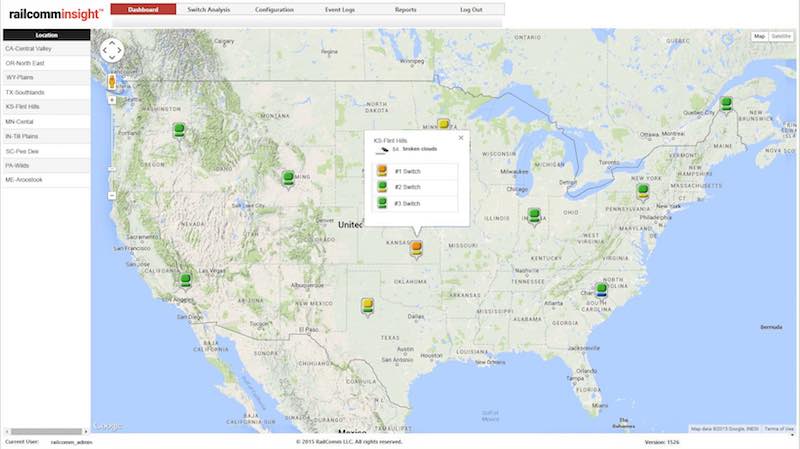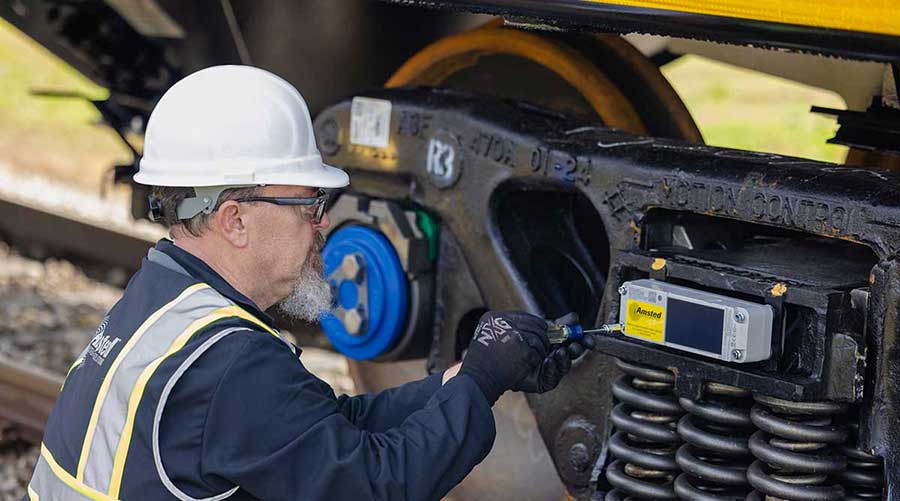Stay updated on news, articles and information for the rail industry
May 2016
Rail News: Rail Industry Trends
Perspective: Evolution of a Smarter View of Rail Switch Health
Class I railroads have been exploring the use of remote condition monitoring of rolling stock and wayside equipment over the last years, so it didn't come as a surprise when RailComm received a request for information from one of its Class I customers for a Switch Current Monitoring solution. RailComm had been working on its smart monitoring and analytics platform with its technology partners, so RailComm was ready to deploy this solution and prove its value. After presenting its solution, RailComm was awarded the pilot project to provide remote condition monitoring for multiple switch locations for this railroad.
RailComm proposed what today is known as RailComm Insight, a smart monitoring and analytics platform for railroad infrastructure. This is RailComm's first Internet of Things (IoT) and Big Data application, providing remote monitoring and predictive analytics for the rail industry.
Using non-intrusive sensors, the RailComm Insight software platform monitors the electric current draw on the switch machine and correlates it with external sources, such as weather, which is a key factor that can affect the performance of a switch.
 Using non-intrusive sensors, the software monitors the electric current draw on the switch machine, correlates it with external data sources, then delivers it via a map-based user interface.
Using non-intrusive sensors, the software monitors the electric current draw on the switch machine, correlates it with external data sources, then delivers it via a map-based user interface.(Click to view larger.)
Source: RailComm
For this railroad, RailComm monitored more than 30 low- and high-voltage switches, the majority of which were Alstom/GRS and Ansaldo/US&S machines. The switches were spread out geographically across 10 locations, and had different operational demands. Some switches were thrown 100 times per month, while others averaged more than 600 times per month.
RailComm Insight automatically analyzes switch data using predictive algorithms on a cloud-based platform to determine if and when assets might fail. The platform is able to predict and detect switch malfunctions related to power source/battery, motor, lock rod, obstructions, and more.
The challenge
The customer deployed RailComm's solution in multiple locations to monitor 30 powered switches across its mainline network. It became obvious very soon that the user interface and the user notifications required some work to make the monitoring of these assets more user-friendly and the alerts "smarter," so as to meet the customer's severity-level requirements.
The railroad was required to perform scheduled-based inspections to all switch machines every 30 days. This scheduling information was also entered into the system to ensure that maintenance did not alter the prediction of switch malfunction.
In a matter of weeks, RailComm developed an alternative user interface. An intuitive map-based interface provides a summary view of all locations and assets, giving a quick understanding of the condition of the switches at a glance. Other views were available to provide detailed historic information on all switch activity for a particular location and/or asset. A better user notification system was put in place that provided smart and actionable data to users, allowing them to subscribe to alerts via emails, text messages, or voice calls for a particular or all locations.
Results
After a year of having RailComm Insight in place, and monitoring over 100,000 switch throws, RailComm was able to predict more than 30 switch failures, equivalent to more than 40 percent of total switch failures.
This prediction rate, which exceeded the customer's expectation of 25%, allows railroads to reduce unplanned train delays significantly. As RailComm continues to collect data and employ machine learning, the prediction rate is expected to continue to increase.
Based on the switch throw information, maintainers have a good understanding of the switch prior to traveling to the switch location. They are also able to determine the efficacy of performed maintenance, and whether maintenance or other track work is affecting its performance.
In summary, using Big Data and Railroad IoT technology, railroads can decrease unplanned delays and minimize their economic impact. They can also improve their trains' velocity and reduce mainline switch maintenance costs.
Click through for more information on RailComm Insight and other RailComm products and solutions.


 LRW Honors Amtrak’s Acheson As Railway Woman Of The Year
LRW Honors Amtrak’s Acheson As Railway Woman Of The Year
 From Editor-In-Chief Foran: Of Gender Equity And Inclusion
From Editor-In-Chief Foran: Of Gender Equity And Inclusion
 Spotlight On Some Of Today’s Rail Safety Products
Spotlight On Some Of Today’s Rail Safety Products
 Women of Influence in Rail eBook
Women of Influence in Rail eBook
 railPrime
railPrime






